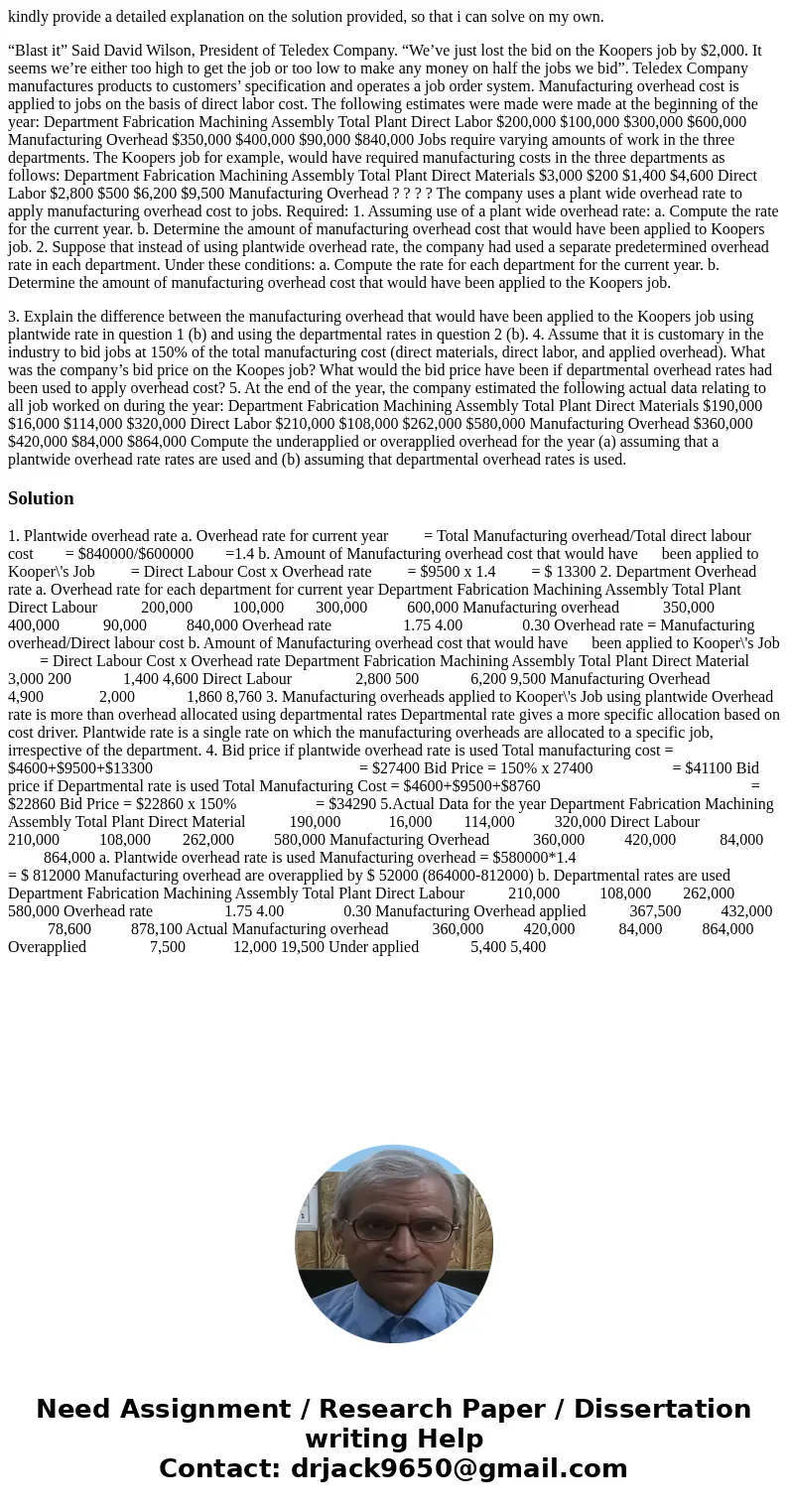kindly provide a detailed explanation on the solution provid
kindly provide a detailed explanation on the solution provided, so that i can solve on my own.
“Blast it” Said David Wilson, President of Teledex Company. “We’ve just lost the bid on the Koopers job by $2,000. It seems we’re either too high to get the job or too low to make any money on half the jobs we bid”. Teledex Company manufactures products to customers’ specification and operates a job order system. Manufacturing overhead cost is applied to jobs on the basis of direct labor cost. The following estimates were made were made at the beginning of the year: Department Fabrication Machining Assembly Total Plant Direct Labor $200,000 $100,000 $300,000 $600,000 Manufacturing Overhead $350,000 $400,000 $90,000 $840,000 Jobs require varying amounts of work in the three departments. The Koopers job for example, would have required manufacturing costs in the three departments as follows: Department Fabrication Machining Assembly Total Plant Direct Materials $3,000 $200 $1,400 $4,600 Direct Labor $2,800 $500 $6,200 $9,500 Manufacturing Overhead ? ? ? ? The company uses a plant wide overhead rate to apply manufacturing overhead cost to jobs. Required: 1. Assuming use of a plant wide overhead rate: a. Compute the rate for the current year. b. Determine the amount of manufacturing overhead cost that would have been applied to Koopers job. 2. Suppose that instead of using plantwide overhead rate, the company had used a separate predetermined overhead rate in each department. Under these conditions: a. Compute the rate for each department for the current year. b. Determine the amount of manufacturing overhead cost that would have been applied to the Koopers job.
3. Explain the difference between the manufacturing overhead that would have been applied to the Koopers job using plantwide rate in question 1 (b) and using the departmental rates in question 2 (b). 4. Assume that it is customary in the industry to bid jobs at 150% of the total manufacturing cost (direct materials, direct labor, and applied overhead). What was the company’s bid price on the Koopes job? What would the bid price have been if departmental overhead rates had been used to apply overhead cost? 5. At the end of the year, the company estimated the following actual data relating to all job worked on during the year: Department Fabrication Machining Assembly Total Plant Direct Materials $190,000 $16,000 $114,000 $320,000 Direct Labor $210,000 $108,000 $262,000 $580,000 Manufacturing Overhead $360,000 $420,000 $84,000 $864,000 Compute the underapplied or overapplied overhead for the year (a) assuming that a plantwide overhead rate rates are used and (b) assuming that departmental overhead rates is used.
Solution
1. Plantwide overhead rate a. Overhead rate for current year = Total Manufacturing overhead/Total direct labour cost = $840000/$600000 =1.4 b. Amount of Manufacturing overhead cost that would have been applied to Kooper\'s Job = Direct Labour Cost x Overhead rate = $9500 x 1.4 = $ 13300 2. Department Overhead rate a. Overhead rate for each department for current year Department Fabrication Machining Assembly Total Plant Direct Labour 200,000 100,000 300,000 600,000 Manufacturing overhead 350,000 400,000 90,000 840,000 Overhead rate 1.75 4.00 0.30 Overhead rate = Manufacturing overhead/Direct labour cost b. Amount of Manufacturing overhead cost that would have been applied to Kooper\'s Job = Direct Labour Cost x Overhead rate Department Fabrication Machining Assembly Total Plant Direct Material 3,000 200 1,400 4,600 Direct Labour 2,800 500 6,200 9,500 Manufacturing Overhead 4,900 2,000 1,860 8,760 3. Manufacturing overheads applied to Kooper\'s Job using plantwide Overhead rate is more than overhead allocated using departmental rates Departmental rate gives a more specific allocation based on cost driver. Plantwide rate is a single rate on which the manufacturing overheads are allocated to a specific job, irrespective of the department. 4. Bid price if plantwide overhead rate is used Total manufacturing cost = $4600+$9500+$13300 = $27400 Bid Price = 150% x 27400 = $41100 Bid price if Departmental rate is used Total Manufacturing Cost = $4600+$9500+$8760 = $22860 Bid Price = $22860 x 150% = $34290 5.Actual Data for the year Department Fabrication Machining Assembly Total Plant Direct Material 190,000 16,000 114,000 320,000 Direct Labour 210,000 108,000 262,000 580,000 Manufacturing Overhead 360,000 420,000 84,000 864,000 a. Plantwide overhead rate is used Manufacturing overhead = $580000*1.4 = $ 812000 Manufacturing overhead are overapplied by $ 52000 (864000-812000) b. Departmental rates are used Department Fabrication Machining Assembly Total Plant Direct Labour 210,000 108,000 262,000 580,000 Overhead rate 1.75 4.00 0.30 Manufacturing Overhead applied 367,500 432,000 78,600 878,100 Actual Manufacturing overhead 360,000 420,000 84,000 864,000 Overapplied 7,500 12,000 19,500 Under applied 5,400 5,400
 Homework Sourse
Homework Sourse